The Soldier's Details

- Surname:
- Dwyer
- First Name:
- William
- Nick Name:
- Bill
- Rank:
- Private
- Regimental #:
- WX20076
- Company:
- Headquarters Company, No. 3 Platoon Administrative.
- Enlisted:
- 24.09.1941
- DOB:
- 7.02.1907
- Place of Birth:
- Kunanalling, Western Australia
- Father's Name:
- John Westby Dwyer
- Mothers's Name:
- Georgina Alexandra Dwyer (nee Rutherford)
- Religion:
- Roman Catholic
- Pre-war Occupation:
- Miner
- Memorial:
- Labuan War Cemetery, Plot H, Row D, Grave 15, Age 38.
- Singapore:
- Selarang Camp and Barracks Changi
- Force:
- 'D' Force Thailand, V Battalion
- Camps Thailand:
- Brankassi, Hindaine, Chungkai, Tamuang, Non Pladuk
- Camps Japan:
- Fukuoka sub-Camp No. 17 Omuta, Fukuoka sub-Camp No. 1
- POW#:
- 4/6090
- Japan:
- Aramis Party
- Cause of Death:
- Acute Colitis
- Place of Death:
- Fukuoka sub-Camp No. 1. Soldier's ashes are believed to have been carried from Japan to Labuan by an unknown serviceman.
- Date of Death:
- 5.05.1945
General Description
William Dwyer was one of two William Dwyers in the 2/4th.
Both were from the goldfields and both lost their lives. William Andrew Dwyer WX10390 died Brankassi 22 August 1943 aged 24 years. Both men were at Brankassi Camp, Thailand with ‘D’ Force V Battalion.
Bill Dwyer’s ashes are believed to have been carried from Japan to Labuan by Australian POW from Fukuoka sub-Camp No. 1 – probably to Manila, then taken to Labuan.
Dwyer enlisted AIF 24 Sept 1941 and joined 2/4th as reinforcement 27 Dec 1941 – joined Headquarters Company No. 3 Platoon.
He was selected with ‘D’ Force V Battalion to work on Burma-Thai Railway at Hellfire Pass Cutting. This Battalion was to endure terrible conditions and had a horrific death rate.
Read about ‘D’ Force V Battalion
It is believed Bill either remained with Cough or was evacuated out from Kuii or Hindaine camps to reach Non Pladuk where he was selected to work in Japan with ‘Aramis’ Party. There were 19 men from 2/4th in this party – all from ‘D’ Force V Battalion.
Read further about ‘Aramis’ Party.
Arriving at Moji, Japan this group were sent to their camp at Fukuoka sub-Camp No. 17 Omuta. Please read further about Omuta Camp, Japan.
On 5th November 1944 WX4924 Joe Swartz and WX20076 Bill Dwyer were sent to Fukuoka sub-Camp No. 1 which was the Western Army District Intendance (Accounts) Department. Joe remained here until 5 May 1945 when he was again moved to Moji No. 4 Camp where he worked on the wharves until the end of the war.
WX20076 Bill Dwyer succumbed to acute colitis on 5 May 1945. He was 38 years old.
Below: POW Record of Bill’s death.

The following is taken from an Affadavit from Geoffrey Thomas UNDERWOOD of Evandale, HUGHENDEN in the State of QUEENSLAND, and formerly QX11013 Gnr UNDERWOOD, G.T., 2/10 Fld. Regt., now discharged, being duly sworn, make oath and state as follows: (former POW of Fukuoka sub-Camp No. 1- there were a very small number of Australians, and were without an officer)
“Medical supplies were practically nil. The only medicines I recall having seen was a small quantity of aspirin. Many Prisoners of War were suffering from diarrhoea, dysentery, beri beri and malnutritional diseases but no medicines were available for their treatment. VX36824 Gnr L CHALKER, 4 A/Tank Regt; WX20076 Pte W. DWYER, 2/4 M.G. Bn; and S/Sgt SIMS were all suffering badly from malnutrition and diarrhoea.
-
Despite many pleadings on their behalf to the Camp Commander commonly known to Prisoners as “THE OLD MAN” nothing was done for them.
-
S/Sgt SIMS eventually collapsed and was admitted to the crude camp Hospital where he died a few days after his admittance. Shortly after his death approximately fifty American Officers were brought into the camp in an exhausted condition. They had been wrecked at sea and apparently had gone through a terrific ordeal. They were admitted to hospital and apparently the Japanese considered that the hospital was full. CHALKER and DWYER became very ill and, at times, were unable to move about but were still forced to work. Eventually CHALKER collapsed and was admitted to the hospital where he lay almost unattended for three days before he died. DWYER also collapsed and died within a few days of his admittance.”
(This above information will hopefully not be too distressing nor offensive to family members who may read this – information was discovered after extensive searching. http://www.mansell.com/pow_resources/camplists/fukuoka/fuk_01_fukuoka/fukuoka_01/Page02.htm -sadly this is a rare opportunity to learn the appalling conditions at No. 1 Fukuoka.
C. Mellor, Historian, 2/4th MGB Jul 2020)
His body was cremated by the Japanese however instead of being enshrined in Japan, Bill’s ashes were taken to Labuan War Cemetery, initially thought to have been carried by an Australian POW from Japan to Manila then onto Labuan.
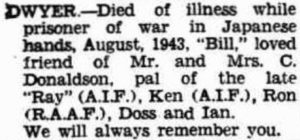
Below: Bill’s name recorded with other 2/4th from Goldfields who lost their lives.
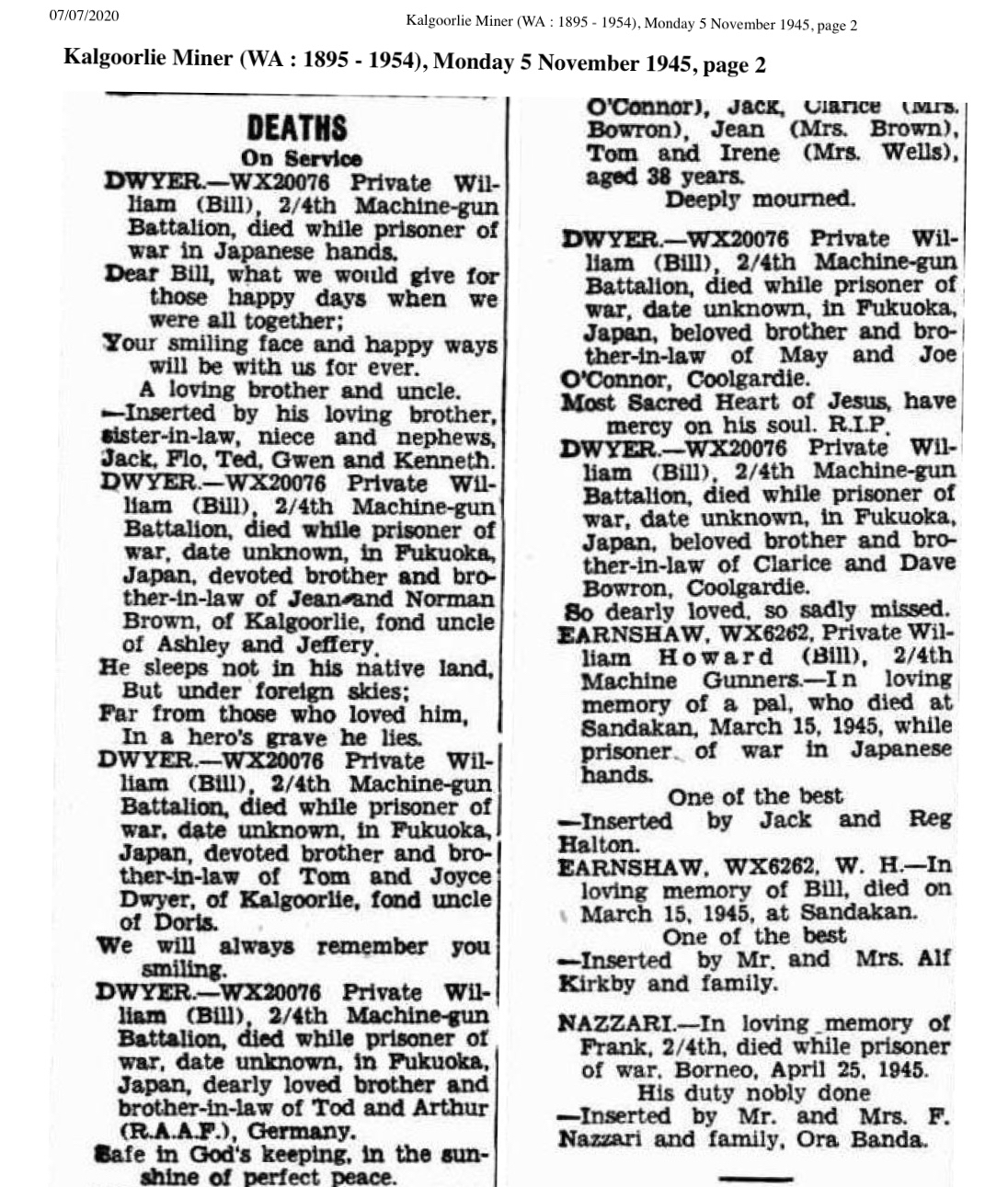
Cont’d P2
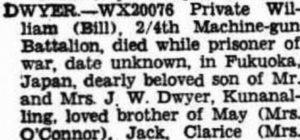

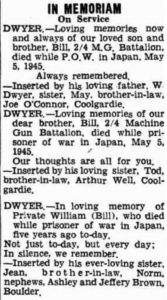
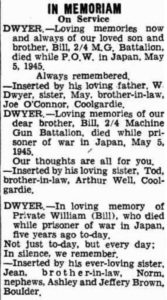
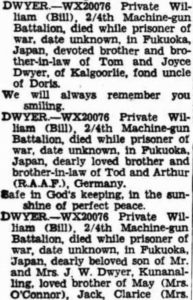
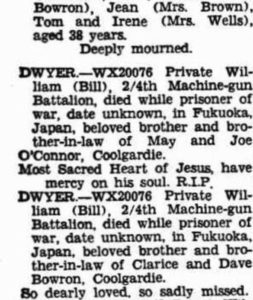
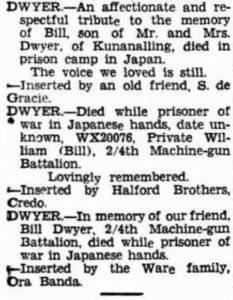

Kunanalling is today an abandoned town north of Coolgardie. Always a town with a small population gold was discovered there in 1895 and was at first called 25 Mile which is how far the townsite was from Coolgardie.
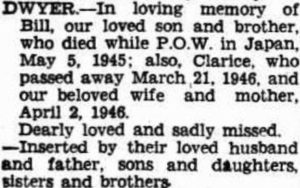
Prior to his enlistment, Pte Dwyer was residing at Kunnanalling, working as a miner.
His parents John Westby Dwyer and Georgina AlexandrIa Rutherford were born Victoria, married Kalgoorlie in 1902. Bill’s father had invested in and worked several mines. The Dwyer family had six children.
Known as Westby, Webb Dwyer’s business interests were in gold mining.
Bill was one of seven children of whom 3 were boys.
Bill’s mother died at Kalgoorlie in April 1946 aged 77 years and his father died in 1955. Both are buried at Kalgoorlie Cemetery.

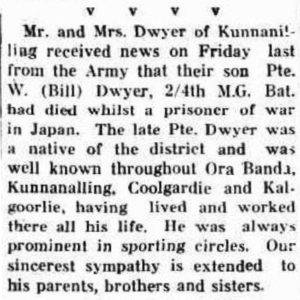
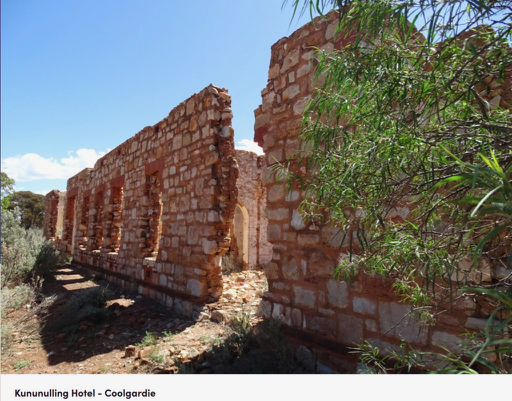
All that remains of Premier Hotel, Kunanulling.

Kunanulling is 25 mile north of Coolgardie, and was also aka the 25 Mile. When gazetted in 1896 the Lands Department applied spelling rules that changed it to Kunanalling in place of 25 Mile or Coonanalling,
One of first hotels in Goldfields to have electricity; provided by a nearby mine, the Premier Hotel opened in 1901, it had ten bedrooms, a large parlour and a billiards room. The town was an important and bustling town during the height of gold mining.




Above notice was following the death of Bill’s sister Mary Clarice in 1946.

Below: 1935 marriage of Bill’s older brother John Westby (Jnr).

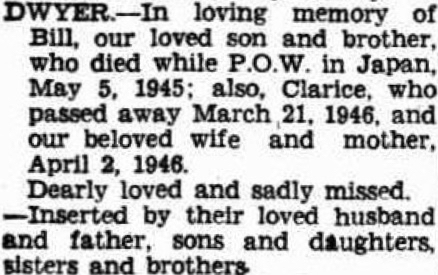
Georgina Dwyer (nee Rutherford) was 77 years old and buried Kalgoorlie. Bill’s sister Mary (Clarice) Bowron was 40 years old when she died in Kalgoorlie – just a few weeks prior to her mother’s death.
Bill’s father died in born Ballarat 1879 died Coolgardie 1955.
Below: Bill’s father’s mining interests.

Below: Bill’s father Webb Dwyer gives evidence during an inquest fatal mining accident 1915.


Above: Bill’s uncle and his father Webb’s brother Leo died 1918 Ballarat a very ill young man. Charles Timothy ‘Leo’ Dwyer had enlisted WW1 and returned home in poor health. Service No 651, Driver 115th Battery, 25th Howitzer Brigade, 5th Divisional Artillery, AIF.
‘June 1916, the 5th Division Artillery moved to France, taking over part of the “nursery” sector near Armentieres. There it became involved in the disastrous attack at Fromelles in July. In October it joined the First, Second and Fourth Divisions on the Somme around Flers.
March 1917 a flying column of the Fifth Division pursued the Germans to the Hindenburg Line, capturing Bapaume. In May the Division relieved the First Division in the Second Battle of Bullecourt, holding the breach thus gained against furious counterattacks. In September it managed to turn an allied defeat into a major victory at the Battle of Polygon Wood.
In March 1918 the Fifth Division was rushed to the Somme region to help stem the German Offensive. There it guarded the vital Somme River bridges. In April it counterattacked at Villers Bretonneux, recovering the town.
The Fifth Division fought in the Battles of Hamel in July and Amiens in August. In September it forced the Somme River at Peronne and fought on to the Hindenburg Line.’


Below: 1938 Kalgoorlie Party – is this Bill Dwyer or WX10190 William Andrew Dwyer – sometimes known as ‘Chunka’ who resided in Kalgoorlie.

Below: Bill’s brothers Jack and Tom.

Below: 1954 Ashley Brown grandson of Webb Dwyer died.

THE HISTORY OF KUNANALLING – Kalgoorlie MIner Newspaper, Wednesday 23 June 1954
(COMPILED BY MB. HARRY G. J. WARE, OF ORA BANDA)
Situated right on the old “90 mile” road, about 20 miles north-westerly of Coolgardie, is the now deserted townsite of Kunanalling, or, as it was known originally, the “25 Mile.” It dates back to 1893 — the very early days of these goldfields.
Records at the office of the Mines Departement, Coolgardie. show that the original gold mining lease applied for at Kunanalling was the True Blue, located about two miles easterly of the townsite, and was pegged out by John Dunne and Alexander Forrest, on November 20, 1893. They were apparently operating for the Lone Hand Mining Co. Other leases applied for about the same time were the Lone Hand, the Sunbeam, the Premier, the Brevier, the Miner’s Dream, the Daddy, the Sovereign and Blackett’s Brilliant. All were registered prior to January 1, 1894. but these form only a small portion of the extensive line of leases in the Kunanalling group which extends from the Star of Fremantle on the eastern end of the field to the London, Kia-Ora and Goulburn group to the west, a distance of approximately eight miles.
It is not difficult to understand that such a long line of gold bearing country provided support for a considerable population, and in addition, Kunanalling was the centre for other areas such as Dunnesville, Jourdie Hills, Carbine, Kintore -The Cement and “Balgari,” There were post and telegraph and police facilities, a coaching stage for Cobb and Co., on the daily run to the “90” mile,” plus the usual general stores, bakery, butchers shop, etc., and three hotels. Public crushing facilities were also available.
It is desired to deal with the mining record firstly, and it is unquestionable that Kunanalling made a very considerable contribution, to the Eastern Goldfields. Following the flush period of the first eight or 10 years, when mining companies were active in the district, it seemed to settle down to a steady production by prospectors, who maintained the town at a regular population. until the late 1920’s. The mining boom following the depression of 1930-31 brightened the place up to some extent, but it was not sustained, and the war years saw it gradually decline to its present state of desertion.
The big motor trucks engaged in the carrying of ore from the Calton mine at Davyhurst to the treatment plant at Coolgardie, roar through what was once the main street, a striking contrast to the teams and coaches of Cobb and Co.’s days. Premier Mine From a geological point of view, Kunanalling is on the division, of the graulte and greenstone, with the ore bodies in the latter. It could claim little importance as an alluvial field, although the Premier gully was a good one, with Proctor’s gully and Rankins and Dead Bird gullies playing their part. The Premier was by far the biggest mine and was equipped with 25 head of stamps, a big cyanide leaching plant, and a filter-press plant for slimes treatment. It was worked to approximately 400 feet, and operations on a large scale ceased by 1904, although tribute parties continued minim for some time after. Five head of the Premier battery was available for the treatment of public crushings.
It was managed for many years by Captain Benjamin Bryant, and later by Mr. F. L. Thomas. It was No. 4 lease pegged n the district, and is included in leases applied for by Dunne and Forrest. Its discovery has been credited to several prominent prospectors including Frost, Cashman, Carr-Boyd, Mercer and Cutmore, and was the subject of considerable litigation. The Premier company also operated the Premier South and the consolidated, which were adjoining, and the Emu, about a mile to the west. Mr. Bob Suitor was an early manager on the Emu.
One of The deepest mines in the district is the Blackett’s Brilliant, or as it was later and better known as Blackett’s Eureka. Worked to a depth of 500 ft, it was equipped with a 10-head battery, and following the cessation of company activities, it was acquired by Mr. F. W. Bow (now of Esperance) who also provided public crushing facilities. Like the Premier, it closed down in the early 1900’s but, as Kunanalling Gold Mines, was the main mine in production in the “boom of the 1930’s.” The syndicate which operated the Miner’s Dream, and Brevier, had a 10-head battery and also treated public ore in the very early days. It is worth recalling that one of this party, Mr. Joe Galvin, had an historic association with Coolgardie, being the first compositor of the original ‘Coolgardie Miner” the first paper on the goldfields. At the Star of Fremantle Mr. W. H. Pearce erected a 10-head battery, which was brought from the North Burgess mine near Bonnievale. Kunanalling Gold Mines acquired the mine and plant from Mr. Pearce, and, under the management of Mr. J. Hill, ore from Blackett’s was treated there. The Shamrock was another mine equipped with a five head battery. Found by Harry Outridge, who had as partners Robert Sutherland and later W. H. Hunter, it was a consistent producer and probably had ‘the longest continuous period of operation” mine in the district, a matter of about 20 years.
The adjoining lease, the Hopeful was found and worked by Messrs. Millar and O’Couner but for a considerably lesser period. A big ore body was developed on the Catherwood, but never was a consistent producer. Several rich patches were obtained adjacent to the Catherwood. The well known prospector Mr, Mickey Larkin and his partner, Mr. Jack Dwyer, being successful on the eastern end. whilst three ladies, Mesdames Kelly and Fox and Miss Ada Mathews loamed for quite a rich patch to the south. They were enthusiastic and competent, and had more than this one find to their credit. Naturally they employed labour to do the necessary mining but the ladies did the surface loading.
Loaming
It was about this period, the mid 1920’s, that loaming was becoming the accepted practice generally, and Mr. Bob Bray applied this method when he located the Nick of Time. After working it for a short time with Mr. Jim Nicholls, the mine was sold to Messrs. Kelly and Fox, who obtained a fair tonnage of high grade battery ore in addition to several rich patches.
Four miles away to the east Messrs. Tom and Edwin Pearce found and worked a similar make of ore on the Brittania, some specimens of which were taken to the Wembly Exhibition in London. A feature of both these holdings was a graphitic formation which can be traced for miles along the hills at Kunanalling, and along which at several places, small patches were obtained, particularly in Quigley’s, Page’s and the Lone Hand gullies. Among other shows on the line that produced only a small tonnage, was the Ruby May, found by Charles Renwick in 1896, and which, when held by Messrs. Hunting, Bewick and Chadwick, produced one parcel of 112 tons for a return of 524 oz. Later it produced several large parcels of somewhat lower grade ore. The Sydney Mint, about a mile west of the London, was also a consistent producer of good grade ore, a specimen of which was bought by the West Australian Government and presented to H.R.H. the Prince of Wales, now the Duke of Windsor, when on his Australian tour in 1920. Messrs. John de Gracie and George Sheedy were working the Mint at that time. It had been held earlier by a man named Berlina, but it is not known if he was the finder. Disagreement As already stated, the True Elue was No. I lease at Kunanalling, and about 1904 it was held by Messrs. Jack Thomasini, George Taft and Heron. Disagreement in the partnership resulted in Thomasini and Heron selling out to Martin Brandt and Jack Fitzgerald, and shortly afterwards Taft, who was a stumbling block to his new partners, sold out to Charles Ware. The lease was renamed the Blue Bell, and about a year later a five head battery was erected on it. Public ore was treated and a few years later, when owned entirely by C. H. Ware, it was the only public crushing plant in the district, and continued to operate as such until 1928. In the 23 years of operation, the Blue Bell battery treated approximately 23,000 tons of ore for an equal number of ounces of gold, a fair record for any district, particularly in view of the fact that Kunanalling has no big soft lodes, such as are a feature of some districts. Messrs. Ware and partners crushed more than 2000 tons from the Blue Bell before hard ground and water made expenses too high. On the adjoining lease, the Nil Desperandum, Norman Robertson and Charlie Mutzic, in a hectic seven months from January to July, 1805, recovered 200 oz. from 97 tons. In addition to this they dollied specimens for a yield of 400 oz. Late in 1911, whilst cutting wood for the Blue Bell battery, Jack de Gracie, an observant prospector, found rich floaters about a mile south of the Blue Bell. This led to the discovery of the Sadie and the Turn of the Tide adjoining it on the north, this latter being found by Webb Dwyer– and Fred Thomas. Jack de Gracie took his brother George in as a partner, and several fair sized parcels of good value were obtained. Dwyer and Thomas also mined high grade ore. Options were let on both leases to the Associated Northern Company. However, the options were not exercised and Jack de Gracie sold his interest to Syd Kelly who, together with George de Gracie, worked the Sadie to below 200 ft. by hand labour in very hard sulphide quartz. The mine produced more than 2000 tons of better than ounce ore, exclusive of the tonnage produced by the Golden West Co. which operated it in the mid 1930’s. The Turn of the Tide was again under option in 1918 to the Golden Gate Syndicate, and was equipped with a steam compressor and hauling plant. Again the option fell through, and Stephen Keele, of Coolgardie, acquired the interest of Fred Thomas. Dwyer eventually bought out Keele and continued to work the mine with a wages man.
Worked to a depth of over 500 ft the Turn of the Tide was probably the best privately owned mine in Kunanalling. As was the case all over the fields in the late 1920’s, prospecting gave way to sandalwood in Kunanalling. Then with the increase in the price of gold in the ’30’s, fast motor transport, and cartage rebates to Government batteries, etc.
Kunanalling had its share of prospectors who took their ore to the State batteries at Qra Banda or Coolgardie,
First Township
The first township was a shanty town located near the two condensers which provided the water supply, and was adjacent to the present Government dam. The surveyed townsite was a mile to the north, and had four streets, namely Balfour, Chamberlain, Gladstone and Salisbury. Buildings included a large post and telegraph office and quarters, a police station and courthouse and quarters, a school and residence, a Mechanics’ Institute, all built and occupied by 1897, three stores, two bakeries, a butchery, a tobacconist and newsagency, and at that time, two hotels.
The first postmaster was named Jones, and Jerry Lyons was the first police constable. He came from Black Flag, as also aid Sergeant Brown. Mrs. MacGinniss was the first school mistress, and taught in her private residence until the school was completed.
The first families at that school included Bounsels, Budd, Freidlanders, Thomas and Suitors. The assistant teacher Miss Pombart, later became head teacher. A man named McDonald built a large store, and following his death by fire in the Denver City Hotel disaster in Coolgardie, the store was run by a Mr. Messer and later still by Mr. George Jackson, who earned a great reputation in the district as one who supported and encouraged prospectors who were having a run of bad luck. Following Mr. Jackson’s departure to the wheat belt in about 1910, Mr. Charlie Wright, who had been employed in the store after reaching school leaving age, carried on the business for many years. Prior to 1900 a family named Dougal transferred & business from Dunnesville to Kunanalling. Arthur Herbert later acquired the store, and Alec Seagram and Jim Doyle also were in business. Sam Bounsell, from Black Flag, set up in business as a tobacconist and newsagent at Kunanalling in 1896, and about the same time Brogan and Mathews, also from Black Flag, started a butcher shop. A butcher shop had been established earlier by Alf Boys (or Boyes) Mr. George Bounsell, one of the original scholars of the Kunanalling school, served his apprenticeship with Brogan and Mathews, and a few years later acquired the business together with a pastoral holding, and carried on until the late 1920’s, when Messrs. Crawford and Pimley, of Carbine, bought the pastoral interest and the butcher shop was closed. In addition to the first baker, a German named Louis, Hunter Bros, had a bakery, a 8 also did Mr. Jack Messer, and George Jackson.
The 25 Mile Hotel, a wood and iron building, right on the main corner was owned and conducted by Mr. Ereidlander, whilst the Royal Hotel was owned by Messrs. Williams and Cummins (the latter of Kalgoorlie Brewery fame). Mr. Fred Bow, who had mining and carrying interests in the district, built the Premier Hotel, a beautiful brick and stone building, in 1901, and a few years later bought the other two hotels, which were later closed. A few years prior to its closing in 1942, the Premier Hotel was bought by Mr. Jim Crawford of Carbine. Mr. Jack MacGinniss, a very early day resident, was a general carrier in the district, as also was Mr. Jim Doyle, and later Mr. John Thompson, who in addition to his carrying business, held a pastoral run, and regularly sewed a crop in a cultivation paddock adjacent to the Government dam. Motor transport saw the end of horses and drays during the burst of activity in .the district in the 1930’s. A wind storm destroyed the Mechanics’ Institute about 1913, and the police station, by then closed, was used as a public hall.
When the postmistress, Mrs. Hill, left the district in the early 1920’s, the post office was closed. The local residents bought the post office building, and turned it into a hall. Oddly enough, the police station building then became the post office, when the occupant, Mrs. Hughie Beaton, accepted the position of postmistress.
The school, which closed in 1927, was removed to a farm at Tammin, and the police station was eventually pulled down and used to house the plaster walls at Yellowdine. The post office-cum-hall was also used as a school for the increased population of the 1930’s, and eventually became a hall at Widgiemooltha.
Kunanalling was a good district, its pioneers were fine types and great characters. It is a splendid memory.

KUNUNALLING in the Shire of Coolgardie.
We wish to acknowledge and thank Moya Sharp, Owner Outback Family History for the Kununalling photographs.



Camp Locations:
- Selarang Barracks Changi - Singapore
- Selarang Camp Changi - Singapore
- Brankassi, Prang Kasi, 208k - Thailand
- Hindaine, Kui Mang 200k - Thailand
- Non Pladuk, 0k - Thailand
- Tamuang, Tha Muang 39k - Thailand
- Fukuoka, Fukuoka #1-B- Japan
- Omuta Miike, Fukuoka #17-B - Japan





